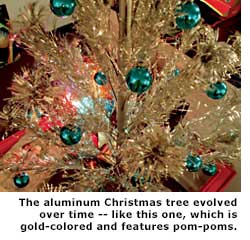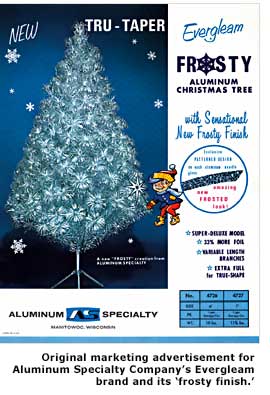Shimmering Nostalgia: The Aluminum Christmas Tree - Page 2
"As we looked more and more closely at the trees in our studio," they wrote, "we became increasingly aware of their psychic presence. We wondered if their antenna-like forms attracted some kind of unknown magnetic energy and absorbed the vibrations into the wooden trunk?"
Their fellow Wisconsonite, Joe Kapler, takes a more hardheaded look, as befitting his position as a no-nonsense historian and curator at the Wisconsin Historical Museum, whose displays of historic aluminum trees have become legendary.
"I doubt that the good folks at Aluminum Specialty were thinking of modern aesthetics when they created this product," he observes. "They were doing aluminum toys, aluminum doggies, things that were classic.
"I'm sure they were not thinking, 'These would be great for all those new homes they're building in California.'"
As Waak recalls it, the mass-produced aluminum tree got its start when Tom Gannon, Aluminum Specialty's vice president in charge of toys, "took a gamble." The company had come upon a much costlier aluminum tree—selling for $75 to $100—invented in Chicago by a firm called Modern Coatings in 1957. "Gannon thought, if we could retail it for $25, and the customer could carry it out of the store in a box, we've got a hit."
Richard Thomsen, who ran Aluminum Specialty's engineering department, called on fellow engineer Wes Martin. Good choice. "If we had a product that we wanted to figure out," Waak says, "we'd give it to Wes. He'd come up with some weird things."
"Aluminum Specialty Co. took a good idea," Kapler says, "and made it great. They made it efficient and saleable."

Soon housewives laboring in converted naval barracks in Manitowoc—a blue-collar town on Lake Michigan that manufactured submarines during World War II—were inserting aluminum branches tipped with aluminum-foil needles into a wooden trunk.
They built the trees two, four, six, and seven feet high, sold them for $20 to $25, and did well when large tire showrooms—which don't sell many tires during the snowy Wisconsin winters—turned their glass-walled showrooms into glowing forests of aluminum trees.
Aluminum Specialty's first Evergleam-brand tree design made its debut at a toy show in spring 1959, pointing ahead to a very, very merry Christmas for the Waak family. "It became an instant hit," Waak says. The company produced between 200,000 and 300,000 Evergleams the first year alone, Waak estimates. "It was a salesman's dream to have this happen. Suddenly the guy who wouldn't give you the time of day is your best friend."
"Aluminum for lasting beauty," the company proclaimed. Aluminum Speciality also provided the Evergleam Color Wheel, the Santa-Light, and Turbo Color Projector to provide "a glorious panorama of slowly revolving colors."

"The thing you have to understand, these were seasonal products," Waak says. "Every season people want something new. These were new, and it catches the eye."
"Within a few years," Kapler says, "they were cranking them out by the millions."
Competition arrived within weeks. Dozens of firms, including Duralite Aluminum, Morris Novelties, Holiday Industries, Regal Electronics, Renown, and Astralite Ltd., were churning out their own aluminum trees. Some came out with budget models, others with luxury trees. Aluminum Specialty played it down the middle—and remained the market leader, with 65 percent of the market share in North America, Kapler says.
As Charles Darwin could have predicted, aluminum trees mutated and evolved over the years. "We tried putting ribbons on the ends of the branches, in different colors," Waak recalls. "Decorative balls. The revolving stand and lights."
Soon silver trees were joined in the forest by trees of pink, gold, and, unbelievably enough, green. By the third year, branches on Aluminum Specialty erupted in 'pom-poms.'
"By crinkling each needle on splitting machines, and curling it, it formed what we called a pom-pom," Waak says. "That was the biggest hit. You got a reflection of every needle because of the crimping, so you had the maximum amount of light being reflected. There was a real brilliance to it."
But, like so many struggling species in our ever-changing world, the aluminum tree was soon facing extinction. Lindemann and Shimon lay much of the blame, ironically enough, on one of America's favorite young men—Charlie Brown—who, in the 1965 TV special 'Charlie Brown's Christmas,' rediscovers the true meaning of Christmas by favoring an honest-to-god, real (sic) tree over Lucy's preference for "the biggest aluminum tree you can find," preferably pink.




